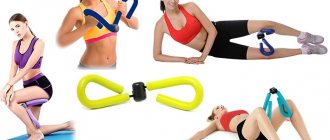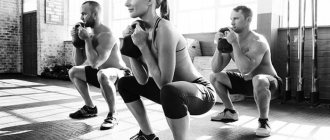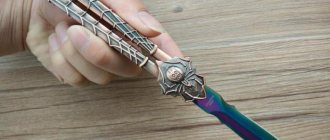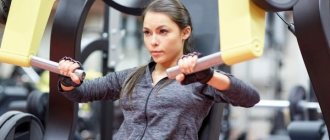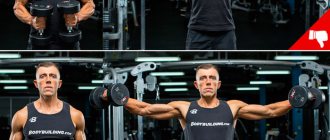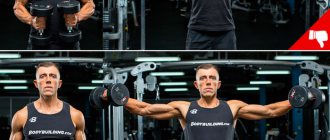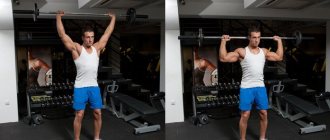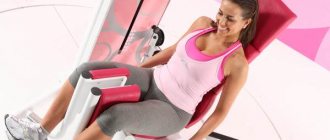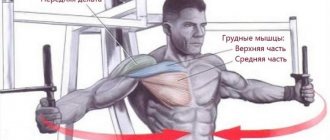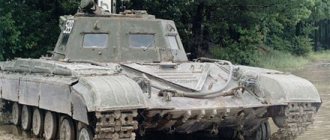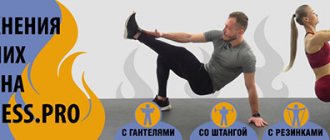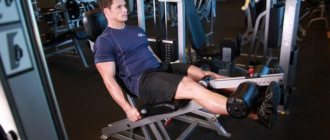Adviсe
1. Try to imagine that you are spreading not your arms, but your elbows. This visualization will help you properly engage your muscles and perform reverse flyes using your rear delts and back muscles, not your arms.
2. Be sure to keep your torso straight and motionless throughout the set. This is a guarantee of both safety and effectiveness of the exercise.
3. It is fundamentally important to hold your breath during the arm extension phase. Firstly, this allows you to develop more powerful force, and secondly, it protects the lower back from injury.
4. To achieve maximum contraction of the posterior deltoid, middle trapezius and rhomboid muscles, be sure to place your elbows behind your back. If this fails, the weight is too heavy or you may need to work on improving your shoulder flexibility.
5. Don't go for heavy weights. The secret to the effectiveness of reverse flyes is strict adherence to the correct form and technique of performing the exercise.
If you find an error, please highlight a piece of text and press Ctrl Enter.
- Try to imagine that you are spreading not your arms, but your elbows. This visualization will help you properly engage your muscles and perform reverse flyes using your rear delts and back muscles, not your arms.
- Be sure to keep your torso straight and still throughout the set. This is a guarantee of both safety and effectiveness of the exercise.
- It is fundamentally important to hold your breath during the arm extension phase. Firstly, this allows you to develop more powerful force, and secondly, it protects the lower back from injury.
- To achieve maximum contraction of the posterior deltoids, middle traps, and rhomboids, be sure to place your elbows behind your back. If this fails,
- This means you're using too much weight, or you need to work on improving your shoulder flexibility.
- Don't go for heavy weights. The secret to the effectiveness of reverse flyes is strict adherence to the correct form and technique of performing the exercise.
Read more: How often should you change your bodybuilding training program for constant muscle growth?
The best rear delt exercises
Theory won't give you anything without practice, so it's time to look at the best exercises for the rear delts that you can use in your training. All of them have been tested in practice for decades and have made it possible to create champion deltas.
Some of the movements for the rear delts are basic exercises, where you can get as big as possible and work with serious weights, up to submaximal ones. However, some isolation exercises cannot be avoided, so we also included them in the top.
Bent-over barbell row
Although the deadlift is considered a basic exercise for the latissimus dorsi, it also works the rear deltoids. If you perform deadlifts on the day of your back workout, it is important to take care of recovery. In this case, “shoulder day” should not follow, you need at least a 3-day break. If you perform deadlifts on shoulder day, do them before doing other exercises for the rear deltoids.
Bent-over barbell rows make it possible to work with impressive weights. With proper technique, this exercise for the back of the shoulder will be extremely beneficial, but try to avoid inertia, jerking and a fast pace of execution.
The execution technique will look like this:
- Stand straight, feet shoulder-width apart. The bar must be grasped with a grip slightly wider than shoulder-width;
- Lean your body forward (keeping your back straight), and then begin to pull the barbell towards your stomach, just below your navel;
- At the top point, pause briefly, then slowly lower the bar to the starting position.
Remember that your back should always be straight, your lower back in a natural position (without a strong deflection). The arms are practically not involved in the work; the movement is carried out due to the strength of the back and deltas.
Bent-over dumbbell row
To specifically load the rear deltas with rows, it is better to do the exercise with dumbbells. This will increase the amplitude and better control the weight. Experts recommend doing deadlifts with one dumbbell, performing approaches on each arm in turn. This will allow you to better support your body with your free hand and maintain your balance. Otherwise, the rules for the technique are still the same: no inertia, slow and controlled movements, maximum amplitude and focus on working the rear deltoid.
Lee Haney Deadlift
This exercise is simply an incredible gift for the rear deltoids. Its creator and popularizer was the legendary Lee Haney, whose peaked delts along with his massive arms created an incredible look. The technique is close to shrugs, but with some differences. In general, the Lee Haney deadlift is a high-quality development of the rear deltoids and trapezius.
Execution technique: place the barbell at the level of your buttocks and approach the rack with your back. Take the bar with an overhand grip (palms facing back) at shoulder level and remove the bar. Start lifting the bar behind your back as high as possible, to approximately the level of your lower back. The exercise is performed at a moderate pace. The rise should be faster than the descent of the bar.
Bent-over dumbbell raises
In bodybuilding, this rear delt exercise is a must for building massive shoulders. This is often referred to as the #1 move for the back bun. There are two versions of the exercise: on a bench and in a standing position. Beginners are often advised to perform flyes while sitting on a bench. This will allow you to turn off your back muscles and avoid inertia. However, you can only get the most benefit from this dumbbell rear delt exercise while standing. First, you can fully control the degree of inclination of the body, adjusting the exercise to your arm length and flexibility. Secondly, you will be able to work with heavy weights.
Exercise on the PECK-DECK simulator
If there is one universal and popular shoulder movement, it is the Peck-Deck exercise. It can be found in almost every room. Often, with the help of Pek-Dek, athletes learn to fully feel the work of the posterior bundle.
In terms of effectiveness and benefits, the exercise in the rear deltoid simulator cannot be called the best. Especially in comparison with barbells and dumbbells. However, in Pek-Dek the nature of the load is most insulating. This makes it quite useful.
Crossover exercises
If you want to get the best performance possible, then lateral raises or crossover rows are the best exercises. Firstly, working in a crossover will allow you to avoid inertia, which significantly reduces the effectiveness of exercises. Secondly, when performing breeding, the main load will fall on the rear deltoids.
The only disadvantage of back swings in a crossover to the rear delta is the shortened amplitude. The cables will not allow you to abduct your arm above a certain level, so it should not be taken as a replacement for bent over flyes with dumbbells. You can use a D-shaped handle and do the exercise with one hand, but in this case you need to make sure that your back and triceps are not too involved in the work.
Afterword
Today we found out how to effectively work the rear delts, and arm raises in the simulator can help us with this. I am sure that you will find a worthy use for this exercise and in the not too distant future you will get cool and round deltoids.
So I say goodbye so that on Friday I can say “hello again!”
PS. and what exercises do you use for the posterior bundle?
P.P.S. Did the project help? Then leave a link to it in your social network status - plus 100 points for karma is guaranteed :).
With respect and gratitude, Dmitry Protasov.
Anatomical features
Many medical sources contain this exercise and talk about which muscles work when bringing your arms together in the butterfly simulator.
Now let’s find out in detail which muscles are actively involved in the work when performing this exercise:
- In this case, the medial muscle will take on the entire bulk of the weight, thereby reducing the load on other less developed muscles.
- The anterior delta is also actively involved in this process and is a stabilizer for other types of muscles.
- Biceps and triceps also take part.
Proper redistribution of the load throughout the body provides an incentive for the development and gain of muscle mass. If you train several times a week and have good rest, then during this time the muscles will effectively recover and be filled with glycogen, which is necessary for muscle development.
Working muscles and grip methods
Reverse flyes directly affect the deltoid muscles (namely, the posterior fascicles). Additionally included:
- trapezius muscle;
- diamond-shaped
Reverse flyes in the simulator can be performed using different grip options:
- the classic, most common type of grip is when the palms are on the vertical handles of the exercise machine opposite each other, and the thumbs are pointed at the ceiling;
- another type of grip is the opposite of the classic one - the hands are directed towards each other with the backs of them, the thumbs are facing the floor, the grip is carried out by the vertical handles;
- the last grip option is specific, since most of the simulators do not have handles for this type of grip - the grip is carried out by the handles, which are located horizontally, the thumbs are directed towards each other, and the palms are facing down.
What is important when doing the exercise?
While doing the exercises, watch your shoulders; they should be at the same level and not rise up; if this is not monitored, there is a high probability of damage to the trapezius muscle groups.
If you are overweight and have a sagging stomach, you should tighten it, this is how you can activate your abdominal muscles and lose volume in the abdominal area.
Beginners should not exercise with heavy weights from the very beginning, as there is a high probability of injury and the occurrence of a hernia in the future, which will negatively affect sports activities.
Always watch your hands and do not pull them back.
Focus on your well-being. If you feel severe discomfort, weakness or coldness in your lower extremities, you should stop training immediately.
Initial position
Before you begin doing arm raise exercises, you will need to adjust some parameters of the machine. Adjust it so that, in a relaxed state, your hands on the handles are approximately shoulder-width apart. When your arms are fully abducted, they should be almost straight and as parallel to the floor as possible.
Directly during the exercise, monitor the position of your own body: the chest should be pressed tightly against the back of the machine, the body should be positioned strictly perpendicular to the floor, the back should have a slight deflection in the lumbar region, the arms should be straight, the palms should be opposite each other.
Exercise No. 4: Dumbbell press while lying on a fitball
The bench press is now one of the most popular exercises among athletes.
The option with dumbbells is no less popular. However, in the second case, the stability of sports equipment is significantly lower, which forces the use of lower working weights. There is also an option to perform this exercise on a fitball, which should not be done. The positive arguments are that the exercise is more natural, but the risk of loss of balance increases significantly, which significantly outweighs the benefits of the exercise. It is best to perform a classic bench press with dumbbells on a horizontal bench.
Execution technique
Before lifting the load, take a deep breath and hold your breath for a while. Then, feeling the tension in your rear deltoids, move the handles as far back as possible. Make sure your elbows move behind the plane of your back. If you want to maximally load the deltoid muscles and turn off the trapezius, try to turn your shoulders forward.
When your arms reach the maximum possible abduction, hold them briefly in this position, continuing to maintain muscle tension, after which you can exhale and return to the starting position. Then hold the starting position for a second and continue repeating the exercise.
Some machines are designed in such a way that it is not possible to perform reverse flyes with completely straight arms, so it is possible to perform them with slightly bent arms. The main condition is the immobility of the elbow joint - it should not move when performing the extension.
Hand raises in the simulator while sitting in front of you: video
Reduction of arms while sitting in the Butterfly simulator is aimed at working the chest muscles. This is an isolation exercise that only works the shoulder joint. Despite the fact that the trajectory of movement is strictly specified by the position of the handles of the simulator, you should remember some of the nuances of the technique for performing the folding and spreading of the arms in front of you. Later in the article we will tell you everything you need to know about this exercise.
website 2017-11-29 Reduction and extension of arms while sitting in the “Butterfly” simulator
Bringing and raising your arms in front of you in the Butterfly machine is an effective exercise for working the chest muscles that does not require significant preparation. The likelihood that you will get injured is minimal. The main focus is choosing the optimal weight for training.
Reduction and extension of arms while sitting in the simulator: technique of execution
- Starting position: sitting on the simulator. We grab the handrails, keep our back straight, fix our shoulders, and bend our elbows slightly.
- We begin to bring our arms together in front of us, and at the final point of the movement we try to press the chest muscles.
- When we bring it down, we exhale; when we bring it back to the starting position, we inhale.
Load on target muscles
Application of the exercise
To whom
. Everyone, from beginner to master.
When
. You can perform it both at the beginning and at the end of training the pectoral muscles.
How many
. Do the exercise in 3-4 sets of 15 repetitions.
Recommendations
To make the work easier when performing the arm abduction exercise, you need to imagine that you are not pulling back the handles of the machine, but your own elbows. This way, you will be able to eliminate your hands from the work and use the target muscles more.
Read more: Exercises for fingers
The body should be as motionless as possible during the exercise; try to fix it in one position. This will ensure greater execution efficiency and safety for you. When performing arm raises, proper breathing will allow you to produce a more powerful effort.
To maximize the involvement of the deltoid muscles, try to move your elbows behind your back as much as possible during the exercise. If you cannot do this, this means that you need to slightly reduce the weight of the projectile or develop greater flexibility in the shoulder joints.
Description of the exercise
It can be performed both in a special simulator and in a “butterfly” simulator.
The essence is the same as the previous exercise. Try to keep your elbows as high as possible. Key tips
1.
Your elbows should be slightly bent at all times.
This is necessary in order to include the rear delta in the work as much as possible. 2.
The seat should be placed so that the hands are approximately at the same level as the shoulders.
Maybe a little higher. 3.
You need to spread your arms until your elbows are level with your shoulders.
I don’t see any point in spreading my arms further and moving my elbows further than my back. Since the shoulder blades begin to come together and the back muscles are already working. 4.
The weight should be such that you can do at least 8 – 10 repetitions.
The exercise is quite safe, however, there is no need for heavy weights here. 5.
It is better that the simulator has special handles for this exercise.
That is, such handles, when grasped, the hands are turned palms down. Then your elbows will look to the sides. This position is optimal for working the rear deltoid. 6.
Your back should be straight and your shoulders slightly back.
Raising arms on the simulator
We are talking about raising arms on a machine, but we can mean six completely different movements. Usually the shoulders and chest are pumped with “flights”; this unites the entire group of movements.
Content
- 1 Purpose of isolation exercises 1.1 In strength training
- 1.2 Isolation exercises in bodybuilding
- 2.1 Typical methods to achieve isolation
- 3.1 There are only three rules for healthy fitness
Basic isolation exercises
Isolation exercises are aimed at developing only one muscle, or a small muscle group. They are used when it is necessary to achieve an aesthetic effect from training, in corrective training to correct posture and habitual posture, and also as auxiliary for strengthening muscles that are lagging in strength. For the most part, such exercises are performed in simulators or on specialized equipment, but there are also a number of classic isolation movements with plates, dumbbells, and barbells.
Benefits and disadvantages of the butterfly chest exercise
- The butterfly trainer allows you to exercise with minimal risk of injury.
- Working in the simulator allows you to develop muscles symmetrically.
- “Pack-deck” creates relief for the muscles.
- The deep muscles of the chest develop.
- Provides excellent stretch to muscles.
- Working in the butterfly simulator increases blood circulation and accelerates the growth of the pectoral muscles.
- Another significant advantage of exercises in the “peck-deck” simulator is the ability to restore the tone of the upper torso after injuries of various types.
- By the way, this simulator is perfect for women. It is able to tone the pectoral muscles and make them more elastic.
For a gym beginner whose goal is to gain muscle mass, this machine will not be a good option. It is not intended to build muscle mass in the pectoral muscles. The pack-deck trainer is an option for experienced athletes who are working on the quality of their muscles, having the required volume, and, of course, for those whose training is aimed at losing weight or maintaining physical fitness, as well as for women.
One of the significant disadvantages of the butterfly simulator is the fixed trajectory of movement. This does not allow you to work the pectoral muscles at the desired angle.
Hand pinch for girls
We could not leave the fair sex aside, because they also want to have a beautiful and athletic body.
More recently, scientists have put forward a theory that girls are 20 times more resilient than men, so they can exercise with heavy loads on exercise machines just like men.
Often after the birth of a child, a woman is faced with the problem of sagging breasts or loss of volume. In this case, there is no need to panic; this defect can be corrected.
Bringing your arms together in a butterfly exercise machine for girls can return your breasts to their original state.
To do this, you need to perform the same exercises that were described above, only with fewer repetitions.
How is the insulating effect achieved?
It is possible to isolate a certain muscle only if you “force” it to perform the movements characteristic of it in everyday life and in everyday life with a load. For example, we can straighten our leg at the knee while putting on a sock, but we don’t put on weighted socks? Unusual movement patterns with weights are one of the reasons why many strength training and fitness specialists do not widely use isolation movements. However, this is too radical - even a non-professional athlete can benefit from isolation. It is only important not to overload his muscles with excessive load.
Typical Methods to Achieve Isolation
- the use of special simulators that allow you to create resistance in movement where the muscle dominates. Examples are leg extensions with weights, leg curls in a machine, biceps curls in a machine, etc.;
- the method is higher, but with restriction of blood movement. The athlete puts on a rubber tourniquet, which “closes” the vessels in the working muscle. Ensures that the muscles are filled with blood, and helps to work them with the least load on the joints, since the minimum weight of weights is used;
- mental control of the muscle in the basic movement and various transfers of the center of gravity. This option is a bodybuilding myth. In basic exercises, for example, in squats, it is not possible to turn off the quadriceps and “turn on” only the buttocks, since flexion and extension of the hip is still carried out. These things were invented to relieve the female beginner from the fear of “pumping” something wrong, as well as to increase sales of personal training. They only “sound” good, but don’t work in practice.
